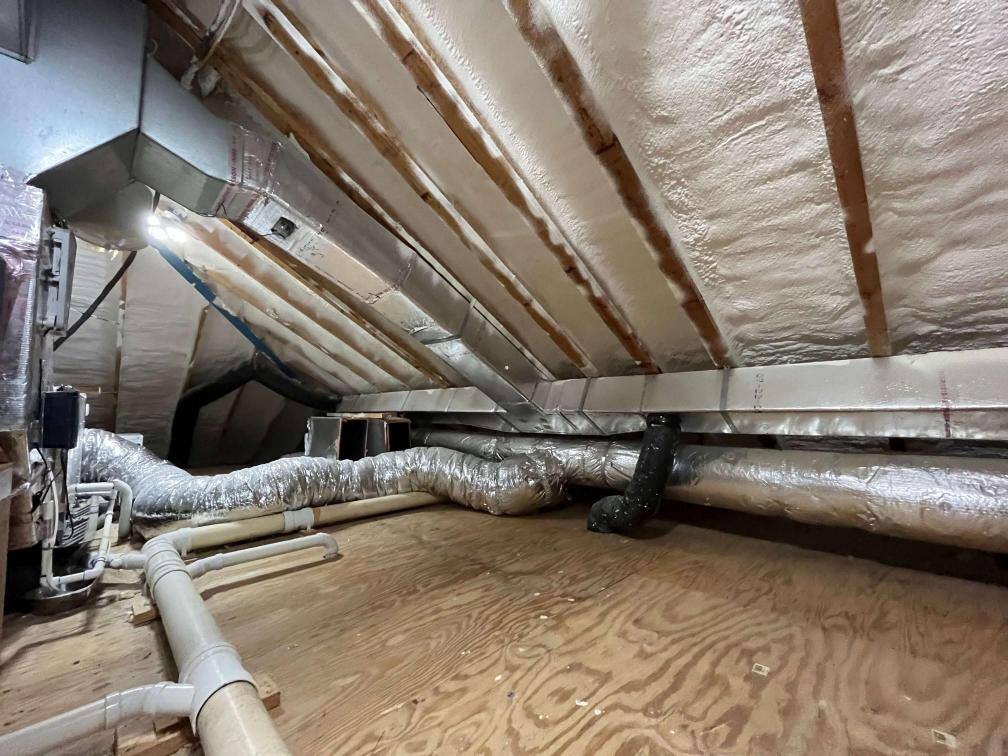Search for topics or resources
Enter your search below and hit enter or click the search icon.

If your HVAC system has some efficiency issues, you may consider insulating your attic ducts with spray foam. Will spray foam adhere to your ductwork? Is spray foam on your ductwork the solution you need to improve your HVAC efficiency?
South Central Services has insulated hundreds of new and existing homes with spray foam. Before becoming an insulation contractor, our founders worked in refrigeration and HVAC. Our team has a holistic approach to home energy efficiency and the relationship between insulation and HVAC.
By the end of this article, you will understand:
Don't have time to read right now? Check out everything you need to know at a glance.
Spray foam can adhere to just about anything, including ductwork. Spray foam insulation is a spray-applied plastic foam that sticks in place. It is possible to spray foam insulation onto ductwork.
The intention behind spraying attic ductwork is to both insulate and air-seal. By coating the duct in insulation, you can eliminate some heat load. Without insulation, ductwork takes on a significant heat load in the attic during the summer.

Since spray foam is spray-applied, it also offers the benefit of an airtight seal. This air-seal prevents hot air from passing through the insulation and reaching the ductwork.
While you can insulate your attic ductwork with spray foam, we generally do not recommend this approach. The primary reason is due to the limitations of spraying ductwork.
Yes, you can spray foam against ductwork. But ductwork is not always accessible for spraying. For the insulation and air-sealing to actually benefit your ducts, the foam needs to encapsulate the ductwork. Inaccessible ducts do not allow for spraying a full 360 degrees around.
You may be thinking, “Hey! Something is better than nothing!” However, in this application, that adage is not necessarily true.
If the entire duct cannot be insulated, it can cause condensation issues. Condensation can form in the area of the ductwork that could not be accessed to spray. Rather than solving some of your problems, partially spraying ductwork will more likely consolidate your issues into one area.
But what about ductwork that is accessible? Does our team recommend insulating accessible ducts?
Even with accessible ductwork, South Central Services generally does not insulate ductwork with spray foam. A fully encapsulated duct shouldn’t cause any harm to your home, but is ultimately not solving the root issue. Spraying the duct is like putting a bandage on a bigger problem.
We recommend attic encapsulation when attics are overheated and HVAC ductwork is struggling with the excess heat load.

Encapsulation of the attic is not always the best or most realistic. However, in many cases, encapsulating the attic removes the excess heat load from the HVAC ductwork and helps to condition the attic air.
Insulating your ductwork with spray foam may make your HVAC more energy efficient. However, encapsulating your attic will support your HVAC and lower your energy costs. Better insulation in your thermal envelope is almost always the best choice when looking to cut energy costs.
You can spray your ductwork with spray foam insulation. It is important to recognize the limitations of spraying ductwork. We would never recommend insulating ductwork if the entire duct cannot be encapsulated. Partial insulation can exacerbate issues and centralize condensation problems.
When appropriate, we recommend attic encapsulation instead. If you’re interested in supporting your HVAC ductwork upstairs and lowering your energy costs, reach out to a qualified insulation contractor about encapsulation.
Now that you understand how spray foam and ductwork intersect, your next step is to:
Disclaimer: While we strive to publish information accurate to building science, local building codes and standards supersede our recommendations.
Kilian has co-owned and operated South Central Services for 8 years. He is passionate about community involvement. In his spare time, he enjoys being with his family, playing ice hockey, and going fishing with friends.
Topics: